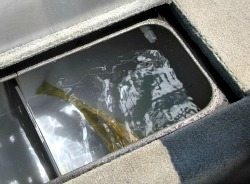Hey, it’s that time again. Temps in the 100’s, water warming fast, and you need to keep your bass alive so you don’t lose valuable weight via penalties assessed for dead fish. Well, we’re not going to jump into the fray and post for or against whatever livewell treatment system you use (save it for your local bassin’ message board), but we do want to pass along some really cool science stuff from Randy Myers, TPWD-Inland Fisheries, in case you haven’t seen it yet.
Randy has posted a couple new slide-share presentations this year that they’ve assembled, including the results of testing on both the use of hydrogen peroxide in livewells, and the performance of The Oxygenator livewell system.
We share the info – you make the call.


























BryanT
July 2, 2012 at 9:21 am
These fall in line with what I have seen also. If you pump fresh water and recirculate (I have a two pump livewell like most tourney rigged boats today). I can keep O2 levels at or near the saturation point in 85* water. The problem and was not so much that livewells don’t do their job, the issue is saturation levels are only 7.8ppm in 85* water. So the biggest benefit is having the biggest livewell available to keep your catch alive.
BryanT
July 2, 2012 at 10:00 am
The TPWD left out an important factor in the Hydrogen peroxide test. Water temp. If water temps were high there is a reason why the O2 spike did not last. O2 saturation was happening the capacity of O2 that the water can hold was met. In the oxygenator test water temps were 68*. That pretty much just proved to me that the oxygenator is not worth it.
It looks like put both your pumps on fresh water pump in and you should be good. Or in real hot temps have 80-120lbs of ice and recirc your wells all day to keep O2 levels up.
Ron Cherkas
July 6, 2012 at 10:10 am
Jay: No need tao post as a reply, but this is from the Wisconsin based Star Paper. It is what started the Wisconsin awareness:
Hundreds of bass found dead following La Crosse fishing tournament
Updated: July 24, 2006 – 3:37 PM
0 comments resize text printbuy reprints
LA CROSSE, Wis. — Hundreds of dead bass have been collected from La Crosse-area river waters, days after a major fishing tournament was held in the region, a state official said.
Nearly all of the 582 bass were marked with a clipped tail fin, evidence they were caught and released during a bass-fishing tournament from July 12-15, said David Hobbs of the state Department of Natural Resources.
This is the second year that higher-than-normal fish deaths were reported in the area following the Wal-Mart FLW Stren Series Bass Fishing Tournament, which attracted 400 anglers.
Last year, most of the dead fish tested positive for largemouth bass virus, which can cause death when the fish is stressed.
The majority of the fish Hobbs collected this year were largemouth, and he said the stress of being caught, held in a livewell and released might be a factor in their deaths.
As part of an ongoing study, the DNR clipped the tail fins of the more than 2,000 bass caught and released during the four-day tournament. The research, conducted by the DNR and fishery biology researchers at the University of Wisconsin-Stevens Point, focuses on mortality rates in bass-fishing tournaments.
The study is in response to a 2003 Wisconsin law calling for an investigation of the economic, sociological and biological impacts of catch-and-release programs in bass tournaments. Results are expected in early August.
Veteran tournament angler Ed Stellner, 53, of Onalaska, said anglers are concerned but they question the DNR study.
“If we are killing the fish, we definitely want to know why,” he said. “However, I also should point out that there’s a bass-fishing tournament in La Crosse every weekend, and when’s the last time you saw this many dead? After last year’s tournament (which was the first year of the study).”
Perhaps the way the DNR conducted the study was a factor, Stellner said.
The agency put about 100 fish a day in 8-by-8-foot holding pens on the Black River. An equal number of tournament-caught fish and fish culled from the wild using electroshocking were kept for a side-by-side comparison.
The pens didn’t have proper current flow, which could have raised water temperatures and limited oxygen levels, Stellner said. Also, the fish were held for up to five days, another possible source of stress, he said.
Hobbs confirmed Stellner’s account of the holding pens but said the electroshocked fish weren’t among those he collected because they did not have a clipped fin.
Hobbs collected the fish from Pettibone Beach to Airport Beach.
Tournament official Dave Washburn of FLW Outdoors, based in Benton, Ky., said Monday that “clearly we’re all concerned” about the fish deaths.
But “we have a lot to learn about how to conduct the study,” He said